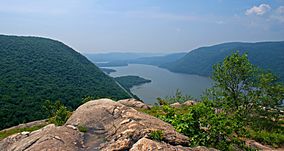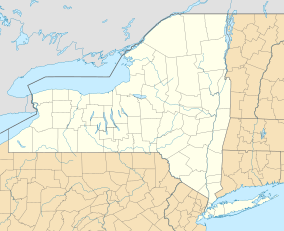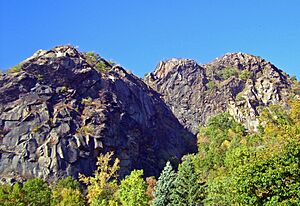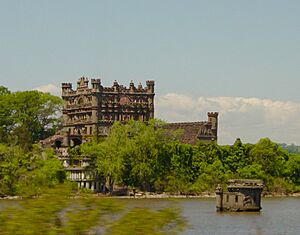Hudson Highlands State Park facts for kids
Quick facts for kids Hudson Highlands State Park |
|
|---|---|

View south from Breakneck Ridge
|
|
| Location | Hudson Valley, New York, United States |
| Area | 11.98 sq mi (31.0 km2) |
| Elevation | 1,260 ft (380 m) |
| Named for | Location in Hudson Highlands |
| Visitors | 224,015 (in 2014) |
| Operator | New York State Office of Parks, Recreation and Historic Preservation |
| Website | Hudson Highlands State Park |
Hudson Highlands State Park is an awesome state park in New York State, located right next to the Hudson River. It's not one big piece of land, but lots of different areas spread out. The park stretches from Peekskill in Westchester County, through Putnam County, all the way to Beacon in Dutchess County. It's located in the beautiful eastern part of the Hudson Highlands.
The park's land was once used for mining, logging, and quarrying (digging out stone). Over time, New York State bought different parts of the land. By 2014, the park covered about 7,669 acres (31.04 km2; 11.98 sq mi)! The park has everything from salt marshes (wetlands near the river) to tall mountain tops. This includes the highest point in the Highlands, the south summit of Beacon Mountain, which is 1,610-foot (490 m) tall.
The New York State Office of Parks, Recreation and Historic Preservation (NYSOPRHP) manages the park. They have offices at Fahnestock State Park nearby. Some parts of Hudson Highlands State Park are next to lands owned by other groups or private preserves. Many of these areas are also open for people to visit.
This park is super popular for day hikes because of its amazing views of the river and mountains. It's also easy to get to by car or train. One of the most famous trails in the park is the steep and rocky climb up Breakneck Ridge. Other trails go up nearby Bull Hill and follow the cliffs of Anthony's Nose. The famous Appalachian Trail (AT) also passes through the park's southeast corner.
Contents
Exploring Hudson Highlands State Park
Hudson Highlands State Park is made up of four separate areas. This is because the land was bought piece by piece over many years.
Southern Park Areas
The southernmost part of the park starts just north of Peekskill. It's next to New York National Guard's Camp Smith. This section follows the Bear Mountain Highway (US 6 and 202) around the lower slopes of Anthony's Nose.
In Putnam County, this area is part of the Appalachian Trail's path along the north side of Anthony's Nose and on Canada Hill. Near a place called Manitoga, which used to be the home of a famous designer named Russel Wright, the AT connects with other trails. It also runs along the edge of the Osborn Preserve. This preserve was once part of a large estate owned by William H. Osborn, a railroad president from the 1800s.
The AT then leaves the state park for a special path owned by the National Park Service. Other trails in this area let you reach Sugarloaf Hill. From its 760-foot (230 m) top, you can see across the river to Highland Falls and the United States Military Academy at West Point. The southern parts of the park end here, near Garrison.
Central and Northern Park Areas
North of the villages of Cold Spring and Nelsonville is the biggest part of the park. This section starts at the Little Stony Point area along the river. It includes Bull Hill and Breakneck Ridge, with Breakneck Brook flowing between them.
This large section stretches into Dutchess County. Here, you'll find Pollepel Island, Sugarloaf Mountain, the south summit of Beacon Mountain, and Beacon Reservoir. The park ends at the Dry Brook trailhead in the city of Beacon. Across the river, you can see Storm King State Park.
The Fishkill Ridge Conservation Area helps connect the central part of the park to the northern part. This area is owned by an environmental group called Scenic Hudson but is managed by NYSOPRHP. The northernmost part of the park is on Sour Mountain and doesn't have trails. It reaches almost to Interstate 84.
Also in Beacon is the 66-acre (27 ha) Denning Point area. This small, wooded piece of land is where Fishkill Creek flows into the Hudson River.
A Look Back: History of the Highlands
Early Days and Resource Use
Swedish botanist Pehr Kalm sailed up the Hudson River in 1749. He wrote one of the first descriptions of the eastern Highlands. He noted the high mountains with woods covering only half their height. The tops were bare, perhaps due to heat, dryness, and strong winds. Kalm also described the mountain laurel, a plant still common there today.
For much of American history, people used the Highlands for their natural resources. They mined for iron and copper. Some of this iron was used to make cannons for the Continental Army during the Revolutionary War. The West Point Foundry in Cold Spring continued making cannons until the late 1800s. People also dug out stone from the mountains, especially on Breakneck Ridge and Bull Hill.
By the early 1900s, most of the easy-to-get minerals were gone. The forests started to grow back. Early hikers began exploring the area, using old paths and roads left from the mining days. One hiker, William T. Howell, wrote about the history of the area. In 1910, he asked for the land to be left wild. He worried that hotels, parking lots, roads, and easy paths would ruin the "wild charm" of the Highlands.
How the Park Was Created
New York State started creating its first state parks in the Hudson Valley in the 1910s and 1920s. They focused on larger areas like Harriman and Bear Mountain. Much of what is now Hudson Highlands State Park was either private estates or owned by companies that wanted to mine.
An organization called the Hudson River Conservation Society (HRCS) worked to protect these lands. They convinced owners to donate land to the state. They also added rules to land deeds that stopped or limited mining.
In 1938, the HRCS had a big success. Rosalie Loew Whitney gave 177 acres (72 ha) on Breakneck Ridge to the state. The next year, people raised enough money to buy 200 acres (81 ha) of Anthony's Nose.
More land was bought in the 1960s. The State Council of Parks (now NYSOPRHP) made a plan to protect the Hudson River Valley. This was in response to companies wanting to build more industries there. For example, a company wanted to dig a huge hole in Storm King Mountain for a power plant. In 1967, the state bought the Little Stony Point area to stop it from being developed.
The park really started to take its current shape in the 1970s. The Rockefeller family's Jackson Hole Preserve foundation helped New York buy about 2,500 acres (1,000 ha) of land. This land became the large central part of the park. In 1974, William Henry Osborn II, a former HRCS president, donated the 1,033-acre (418 ha) Osborn Preserve to the state. In 1992, Scenic Hudson bought the 923-acre (374 ha) Fishkill Ridge Conservation Area.
The northern part of the park became part of a local issue in the late 1990s. It's home to a den of Eastern timber rattlesnakes, which are a protected species in New York. A local quarry operator put up snake-proof fences. The state's Department of Environmental Conservation sued to stop this. In 1999, then-Attorney General Eliot Spitzer got a court order to tear down the fence. This case helped set a legal rule that New York can protect endangered species on private land.
Nature and Wildlife

The plants and animals in the park are part of the Northeastern coastal forests ecoregion. The park has many different natural areas, called biomes. These include brackish tidal marshes (wetlands with a mix of fresh and salt water) and mudflats along the river. It also has pitch pine-oak-heath rocky summit forests and rocky grasslands at higher elevations. This variety helps make the park very diverse with many different living things. The mountain slopes are mostly covered by oak hickory and chestnut oak forests.
Besides rattlesnakes, the park is home to other protected species. These include the bald eagle and the least bittern (a type of bird). Three of New York's five known eastern fence lizard groups live in Hudson Highlands State Park. This is near the northern edge of their natural range.
Visiting the Park
The park is open during daylight hours all year. Most people visit for quiet activities like hiking and birdwatching. Some limited hunting is allowed. Bowhunters can hunt deer in the late fall. Shotguns can be used during the spring turkey season.
Some areas near the river can be reached by kayak. There's a state-owned launch for kayaks off the Annsville Circle. This is where US 9 meets routes 6 and 202, north of Peekskill. Camping and open fires are not allowed. There are no special campsites or shelters in the park.
Pollepel Island is a short distance from the east bank of the river. However, it's the only part of the park where access is limited. You can only visit the island and the ruins of Bannerman's Castle by arranging a guided tour through NYSOPRHP. Bannerman's Castle is listed on the National Register of Historic Places.
Getting to the Park
Most people enter the park from its western side. NY 9D runs near or along the park's edges, especially between Cold Spring and Breakneck Ridge. Two main trailheads (starting points for trails) are along this section at Little Stony and Breakneck points.
The Osborn Preserve and Anthony's Nose areas have trailheads along the Bear Mountain Highway. You can also access them at the Appalachian Trail crossing on South Mountain Pass Road, south of Canada Hill. The AT's meeting point with US 9 and NY 403 allows access from the east. In Garrison, you can also use trails from Manitoga and the Castle Rock Unique Area to reach the park areas on the ridgetops.
The Fishkill Ridge areas and Mount Beacon are often climbed from the east. You can follow the Fishkill Ridge trail from its northern end at Pocket Road in Beacon. From the west, you can reach them from the Wilkinson Memorial Trail on Old Albany Post Road North, just south of the county line along US 9.
Hikers coming from the south can also take the train to the trails. Metro-North Railroad's Hudson Line runs next to NY 9D and the east bank of the river. There are special "request stops" at Breakneck Ridge and Manitou. Breakneck Ridge station is close to the trailhead and parking lot. Manitou station is right by the river, so you'll need a short climb to reach the Manitoga and Canada Hill areas. Trains stop at these stations only on weekends. Northbound trains stop in the mornings, and southbound trains take hikers back in the evening. At other times, hikers can use the Cold Spring station, which has regular train service.
Popular Trails for Hiking
Volunteers from the New York-New Jersey Trail Conference help maintain the park's trails. They also publish detailed maps. Some trails follow old roads from the quarrying and mining days. Others climb the steep and rocky peaks directly. The trails are marked with plastic disks from NYSOPRHP, except for the Appalachian Trail, which uses white paint marks.
Many trails offer amazing views over the river and the region. This is because they follow the tops of ridges and have thinly wooded summits.
Here are some of the longer and more popular trails in the park:
- Appalachian Trail (AT): A 5.1-mile (8.2 km) section of this very long trail (from Georgia to Maine) goes through the southern part of the park. It's near the Osborn Preserve. From NY 9D, it climbs Canada Hill and follows that ridge for two miles. Then it goes down to the US 9/NY 403 junction.
- Breakneck Ridge Trail: This is one of the most popular trails! The western part is a tough challenge. It climbs 1,250 feet (380 m) in its first 0.75 miles (1.21 km) through steep, rocky sections. You'll need to use your hands to climb (scrambling). The views of Storm King Mountain and Newburgh Bay are incredible. The whole trail is 4.6 miles (7.4 km) long and continues over the mountain to South Beacon Mountain.
- Camp Smith Trail: This 3.7-mile (6.0 km) trail follows a narrow path between the National Guard base and the Bear Mountain Highway. It crosses Anthony's Nose. It has many steep and rocky parts with views of Bear Mountain, the bridge, and Haverstraw Bay to the south.
- Fishkill Ridge Trail: Starting from the Pocket Road trailhead in Beacon, this 4.9-mile (7.9 km) trail makes a big loop over the mountain. You'll get some views over Fishkill and southern Dutchess County.
- Notch Trail: This 5.8-mile (9.3 km) trail follows old wood roads. It goes from near the top of Bull Hill, down into the valley, and up the north side of Breakneck Ridge. It joins the Breakneck Ridge Trail for 1.3 miles (2.1 km) along the ridge. Then it goes down to Squirrel Hollow Brook and continues across the lower slopes of South Beacon Mountain to reach Route 9D.
- Osborn Loop: This 3.4 miles (5.5 km) trail connects to the AT near Canada Hill at both ends. You can reach it from Manitoga, the AT, or the trails around Sugarloaf Mountain.
- Undercliff Trail: This four-mile (6.4 km) trail goes from Nelsonville to Breakneck Ridge. It crosses the shoulder of Bull Hill along the way. It's called "Undercliff" because it passes below many cliffs.
- Washburn Trail: This is the main way up Bull Hill from the Little Stony Point trailhead, just north of Cold Spring. It climbs the mountain's 1,420 feet (430 m) in almost 2.3 miles (3.7 km). This is the biggest climb of any trail in the park.
- Wilkinson Memorial Trail: This is the longest trail in Hudson Highlands State Park at 9.5 miles (15.3 km). It starts along NY 9D just north of Breakneck Ridge. It gradually climbs to cross all the summits of Scofield Ridge, which is the highest peak in Putnam County (but outside the park). It then goes down to Old Albany Post Road North, near US 9.






